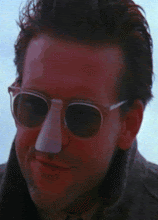 |
Sunday, 28 October 2012
One Function of the Guardian/Observer for the Middle Classes (Neatly Encapsulated in the Title of a Single Article)
Monday, 22 October 2012
The Demon in the Machine: Paranormal Activity 4
The idea which runs through the Paranormal Activity series is that the visual technology which is
so much a part of contemporary life might just capture something horrible,
either by accident or design. In the original film (2009), a couple attempt to
make sense of frightening paranormal disturbances which have been occurring in
their new home at night – a light turning itself on and off in the hallway, a
door opening by itself, loud thuds and crashes upstairs, etc. – by mounting a
digital camera in their bedroom and recording while they sleep. This is
followed by handheld cameras in Paranormal
Activity 2 (2010), security cameras in Paranormal
Activity 3 (2011), a prequel to the original, and now, in this fourth
instalment, a series of networked laptops recording continually via webcam throughout
the house.
Our handheld digital world has had a huge impact on
cinema, and not just because the compact nature of digital cameras and
smartphones – and their low prices – makes filming accessible to all. Where the
mediatized global catastrophes of the Sixties were televisual (the
assassinations of the Kennedy brothers, for example), in the twenty-first
century, they have been digital. One effect of this is the way footage from
9/11 and the 2004 Tsunami taught film-makers how to really ‘do’ realistic disaster
(e.g. in Cloverfield - see previous post). But what Paranormal
Activity suggests is that there is something disturbing about the
technology itself, something
dangerous about our very compulsion to record every moment of our lives. What
if the devices we deploy to protect ourselves should uncover, or even unleash, a
submerged world we would be better off not knowing about?
 |
| Jane and Louise Wilson |
In its heyday in the late Eighteenth
Century, gothic fiction specialized in exotic, enclosed spaces, fitting
locations for heightened drama, such as
the rooms in castles or monasteries. Now we are as likely to encounter the gothic
in the ordinary spaces of our everyday world – not only the urban architectural
spaces explored in the photography of Jane and Louise Wilson, but in everyday
suburban kitchens, bedrooms and garages. ‘Suburban Gothic’ is a label coined by
Bernice Murphy to refer to a major sub-genre within American gothic over the
past few decades, which expresses the anxiety that beneath the surface of the
most mundane of environments something extraordinary is lurking, something
virulent or evil. The Paranormal Activity
series is a recent example of a sequence of films that include Halloween (1981) and Disturbia (2005). The original film was
set in a modest example of ‘tract’ housing, the sequels in more affluent villas.
Each, though, is representative of ‘suburbia’.
From the outset, the plot has been the weakest link in
the Paranormal Activity series,
despite the creditable attempts to embellish it in the sequels. A demon has
attached itself to one of two sisters, staying with her throughout her life as
she moves from one suburban locale to another, making sure she and her
offspring stay in his possession, eliminating anyone who gets in his way. But
why this is the case, and even how it works, is less clear. In a way the story
is rather un-gothic: demons are more
monstrous but less uncanny than ghosts.
But in the end this doesn’t matter. In Paranormal
Activity 4 the simple plot –
demon wants boy back – is just a pretext for the real business of the film: to
show us how menacing the spaces of our ordinary lives are. The films gives us
the Freudian uncanny in an especially direct sense: our homes are made unhomely
by the act of scrutiny. It may be that the most problematic inconsistency of the
story is the fact that a force formidable enough to drag adults through
rooms, start cars, and send chandeliers crashing down on people, is apparently
unable to turn off a laptop. Yet this demon has no interest in stopping the
camera, for it is his biggest ally.
*Bernice Murphy, Suburban
Gothic in American Popular Culture (Palgrave, 2009)
Subscribe to:
Comments (Atom)


